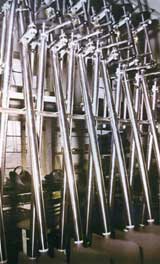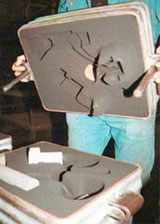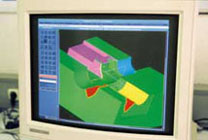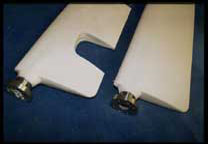|
Why do we build our systems in diecast aluminium? Why did we move away from handcrafted stainless steel production in 1984 and what are the other options? Read on! Building by Hand: 1968-1984In the early days of recreational sailing boats were built by hand. Deck fittings were made from stainless steel or bronze and seawater-resistant aluminium was unknown. Demand then was too small to justify industrial-scale production and costs were about evenly split between development, materials and wages. Now mass production is the rule rather than the exception. Design and manufacturing have raced ahead and we expect much more from our purchases in terms of both quality and appearance. Like it or not, the world has moved on for all of us - or are you still driving that old VW? Hand Made in Stainless Steel: 1968 – 198416 years of building by hand in stainless steel taught us a thing or two: Allowances have to be made for material tolerances! Why? The dimensional tolerances for industrial stainless steel tubes tend to be on the generous side, which means some joins have to be enlarged and others packed with washers and no two cases are the same. Stainless steel exhibits considerable deformation under welding (which only exacerbates the problem of tolerances). For financial reasons many tubular stainless steel materials are made from rolled and welded sheet rather than extruded. The welded seam may be hard to discern from the outside, but it's clear to see on the inside and it affects both susceptibility to corrosion and bearing design and performance (a matter of tolerances once again). What about corrosion? Stainless steel tubes are manufactured all over the world, but not always with the same degree of enthusiasm for industrial standards! V 2 A (DIN 4301) stainless has a lower chromium content but is easier to polish. That means the surface can be made smoother, which is the best way to protect it against corrosion. V 4 A (DIN 4571) stainless contains more chromium and is therefore more resistant to seawater, but is accordingly more difficult to polish. Surface protection? The best way to protect the surface against corrosion is to polish it mechanically until smooth. Unfortunately mechanical polishing is a slow and laborious chore, so for those ever-present financial reasons most stainless components are now electropolished. Electropolishing, however, merely pickles and brightens the surface and does not remove manufacturing and grinding marks. The appearance of electropolished surfaces therefore changes quickly in seawater and a rust film will quickly become established without regular attention. WINDPILOT only ever used mechanical polishing processes for its systems. And repairs? Stainless tube products are difficult to repair with the tools typically carried afloat, as the large diameter thin-walled tubes are reluctant to bend (or be straightened). Even welded repairs can be problematic for the same reason. Sand-cast Aluminium: 1984 - 1997The sand casting method played an important role in the development of industrial manufacturing. Once a model of the component had been made (usually from wood), it could be used over and over again to shape sand moulds for casting. The actual casting process, on the other hand, was usually still very much a manual task - catch the man with the ladle in a bad mood and a whole day's work could end up having to be melted down again! The process:
Ever more stringent quality requirements and a growing insistence on vanishingly small tolerances led in the 1990s to the demise of a great many small casting shops, all but a very few of them wage-intensive sand casters who could no longer make ends meet.
Aluminium Pressure Diecasting since 1997The pressure diecasting process is used throughout industry for the manufacture of aluminium components and is standard in the automotive sector. The process: The two-piece mould (die) for the casting is manufactured in cast iron in a CNC machining or erosion process. The two halves of the mould are brought together to form a cavity, which is then filled with molten aluminium in the absence of air. The whole casting operation is pre-programmed and controlled automatically. Advantages:
Our manufacturing standards are second to none: when our suppliers aren't making Windpilots, they're busy producing parts for DaimlerChrysler! Our use of pressure diecasting for components made from AlMg5 aluminium alloy is a first in Western Europe. WINDPILOT is the only manufacturer to produce a modular range of windvane steering systems and multivariable mounting components ready for easy owner installation on just about any type of sailing boat. Thanks to the latest production methods, WINDPILOT is able to offer these high tech solutions at surprisingly attractive prices. WINDPILOT - moving with the times!
Rotational Moulded Auxiliary Rudder Blades since 2000WINDPILOT has recently broken new ground in the production of the auxiliary rudder blades for the Pacific Plus. Everyday life is full of rotational moulded objects (all hollow), from plastic fuel containers to children's toys and even chocolate Easter bunnies: now you can enjoy the benefits of this technology at the back of your boat too! The process:
What makes our rotational moulding process so innovative? In a word, strength: the powder and the beads used comprise the same basic substance (polyethylene), so the foam core actually forms an integral bond with the exterior skin. Rudder blades produced by this means are virtually immune to mechanical damage and are so buoyant that they will float despite the heavy stainless steel shaft. This is a major plus for WINDPILOT systems, as a buoyant rudder means dramatically less bearing friction and that in turn means better performance in light airs. Our rotational moulding pilot project has attracted considerable attention in technical circles worldwide and has been exhibited at ARM (Association for Rotational Moulding) trade fairs in both Europe and the USA. The new rudder, which is also removable, has been shipped with all WINDPILOT Pacific Plus systems since March 2000.
|
|||||
 |
|||||
 |
|||||
 |
|||||
 |
|||||
 |
|||||
 |
|||||
Why WINDPILOT?Because we never stand still! |
|||||
